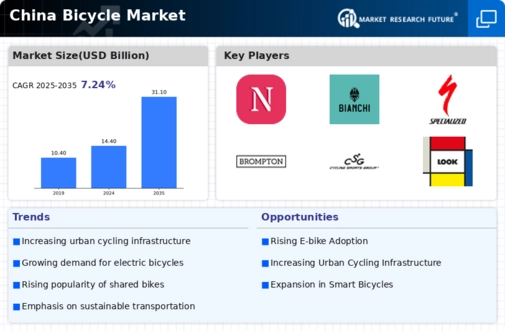Health and Fitness Awareness
Growing health consciousness among the Chinese population is driving the bicycle market. As more individuals prioritize fitness and well-being, cycling emerges as an appealing activity that combines exercise with transportation. Recent surveys indicate that nearly 60% of urban residents in China consider cycling a vital part of their fitness routines. This trend is likely to result in increased bicycle purchases, particularly among health-conscious consumers. Additionally, the rise of cycling clubs and community events promotes social engagement through biking, further enhancing the appeal of cycling. Consequently, the bicycle market is expected to experience sustained growth as more people integrate cycling into their daily lives.
Urbanization and Population Density
Rapid urbanization in China is significantly impacting the bicycle market. As cities expand and population density increases, the demand for efficient and space-saving transportation solutions grows. Bicycles offer a practical alternative to congested public transport and traffic-clogged roads. In 2025, urban areas are projected to account for over 70% of the total bicycle sales in China. This trend indicates a shift towards cycling as a preferred mode of transport in densely populated regions. Moreover, the convenience of bicycles in navigating urban landscapes is likely to attract more commuters, further driving growth in the bicycle market. The interplay between urbanization and cycling adoption suggests a promising future for the industry.
Environmental Regulations and Policies
Stringent environmental regulations in China are influencing the bicycle market positively. The government is actively promoting cycling as a sustainable transportation option to combat urban pollution and reduce carbon emissions. In 2025, it is estimated that cities with robust cycling policies could see a 20% reduction in vehicular emissions. This regulatory environment encourages consumers to consider bicycles as a viable alternative to cars, thereby increasing market demand. Additionally, incentives such as subsidies for electric bicycles further stimulate growth in the bicycle market. As environmental awareness continues to rise, the bicycle market is likely to thrive in response to these regulatory pressures.
Technological Advancements in Bicycle Design
Innovations in bicycle design and technology are reshaping the bicycle market in China. Manufacturers are increasingly incorporating advanced materials and smart technologies into their products, enhancing performance and user experience. For instance, the introduction of lightweight carbon fiber frames and integrated GPS systems has attracted tech-savvy consumers. In 2025, the market for high-end bicycles is projected to grow by 15%, driven by these technological advancements. Furthermore, the rise of connected bicycles, which offer features such as fitness tracking and navigation, is likely to appeal to a younger demographic. This trend suggests that the bicycle market will continue to evolve, catering to diverse consumer preferences.
Government Support for Cycling Infrastructure
The bicycle market in China benefits from increasing government support aimed at enhancing cycling infrastructure. Initiatives include the construction of dedicated bike lanes and parking facilities, which are expected to improve safety and accessibility for cyclists. In 2025, the Chinese government allocated approximately $1 billion to develop cycling-friendly urban environments. This investment is likely to encourage more individuals to adopt cycling as a primary mode of transportation, thereby boosting demand in the bicycle market. Furthermore, local governments are implementing policies that promote cycling as a sustainable alternative to motor vehicles, which may lead to a significant increase in bicycle sales and usage across urban areas.




















Leave a Comment